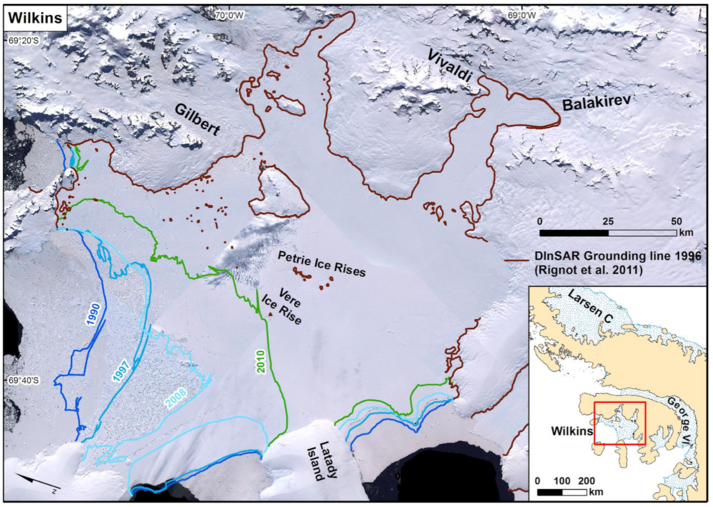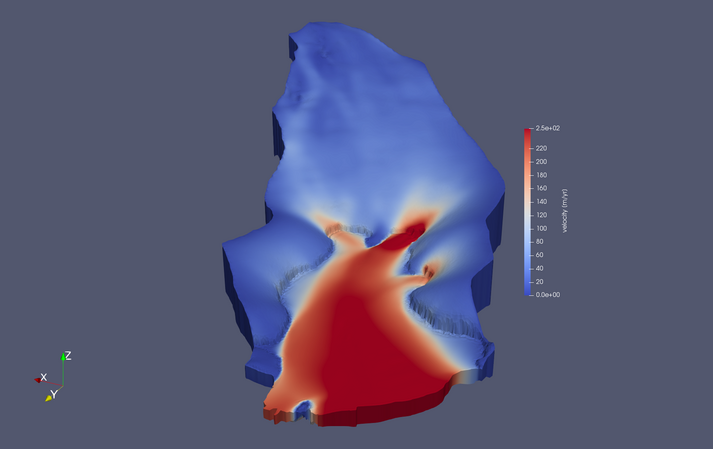
Most ice shelves on the western Antarctic Peninsula show or have experienced considerable retreat or even complete disintegration in the last few decades. Recent studies have linked this partly to upwelling of warm Circumpolar Deep Water (CDW), which is supposed to influence particularly the southwestern Antarctic Peninsula region. However, the exact processes and mechanisms as well as the sensitivity of the region to further ice shelf and glacier thinning and retreat are not known or not well constrained. This is partly because of lacking observations and the demanding modelling efforts. In this study, we propose to analyse time series of remote sensing data to derive various glaciological variables such as surface velocities, surface elevation change, grounding line and ice front positions as well as structural variables. We will provide this analysis for entire large-scale catchments on the southwestern Antarctic Peninsula. We will combine the remote sensing data sets to compute temporally high-resolution ice mass discharge estimates with two independent methods. Those data sets will form a contribution to international efforts such as Ice sheet Mass Balance Inter-comparison Exercise (IMBIE) or the next report of the Intergovernmental Panel of Climate Change (IPCC). The above-mentioned remote sensing products will then be used for calibration and validation in forward simulations for the ice shelve retreat in the region with an ice dynamic model. The employed ice flow model is the Ice-Sheet and Sea-level system model (ISSM) in Blatter-Pattyn approximation and an envisaged resolution down to 200-500m at the grounding line. The aim of the numerical modelling studies is two-fold. In a first step, the mechanisms for recent ongoing changes are investigated. Here, we focus on the importance of ice-shelf buttressing and the impact of ice shelf melting (ice-ocean interaction). This step heavily builds on remote sensing products assessing the quality of the transient simulations. In a second step, the future stability of ice shelves and glacier tributaries is estimated. In accordance with the COordinated Regional Downscaling EXperiment (Polar-CORDEX) modelling strategy, the focus is on the Representative Concentration Pathway (RCP) 8.5 scenario. To tackle these questions we will rely on suitable oceanic and atmospheric fields. In particular, we strive to use data-sets of the ongoing efforts with the Finite Element Sea ice-Ocean Model (FESOM) to include ice shelf cavities in the modelling framework (ongoing ECHAM6-FESOM coupling for the Climate Model Intercomparison Project (CMIP) 6 and from the Polar-CORDEX activity).
Project funded by the Priority Programme 1158 of the German Research Foundation (DFG): Antarctic Research with Comparable Investigations in Arctic Sea Ice Areas
Project title: Climate sensitivity of western Antarctic Peninsula ice shelves (CSAPIS)
Project managers: Professor Dr. Matthias Holger Braun (FAU Erlangen), Dr. Martin Rückamp (BAdW)
Project partners: Dr. Shelley MacDonell (CEAZA, Chile), Sebastian Marinsek (Universidad de Morón, Argentina), Dr. Christian Wild (Oregon State University, USA)

This interdisciplinary project integrates high-resolution seismic mapping with numerical models of ice dynamics, erosion and sediment transport to quantify the past and present interaction between glaciers and the solid Earth. We thus aim to test the hypothesis that subglacial sediment production, transport and deposition are key parameters for the past and present ice dynamics and stability of the Antarctic. For this purpose, a comprehensive source-to-sink concept is applied in one of the best limited glaciated catchment areas, the Ekströmisen in Dronning Maud Land, Antarctica. In the current debate on the stability of ice sheets and paleoclimatic conditions, we will help answer the following pressing scientific questions: How do Antarctic catchment areas behave over several glacial cycles? How did the grounded ice retreat in the Holocene? What are the decisive conditions for rapid ice transport in the catchment area? To what extent do erosion and deposition processes and the underlying strata influence ice dynamics and stability?
In order to answer these questions, we will link existing seismic data from subglacial layer packages with aero-geophysical information (ice thickness and internal stratigraphy from radar, geology from gravimetry and magnetism) and products of satellite remote sensing (surface height and ice flow velocity). A coupled higher-order ice flow-hydrology model is used to quantify the ice dynamics. Initial conditions (distribution of liquid water and basal sediment and subglacial bedrock properties) are derived from radar and seismic data. Ice-dynamic simulations are coupled with a numerical model of glacial erosion, transport and deposition. These models will quantify the development of geometry, mass transport and basal conditions of the Ekströmisen catchment area over several glacial-interglacial cycles and will allow the investigation of possible feedbacks between basal sediments and ice dynamics. Observed sediment structures and core profiles are used to validate the simulated flow behaviour and erosion/sedimentation processes. Utilising the confined geometry of the Ekström basin, the project will overcome the limitations of the previous large scale source-to-sink sediment studies with multiple source regions and unconfined deposition zones. We will be able to quantify the ice-dynamic interaction with the continental bedrock and the coupling between the glacial and solid Earth system with unprecedented accuracy.
Project funded by the Priority Programme 1158 of the German Research Foundation (DFG): Antarctic Research with Comparable Investigations in Arctic Sea Ice Areas
Project title: Constraining paleo-dynamics and sediment transport of Antarctic stream flow across grounding lines - from source to sink
Project managers: Todd Ehlers (U Tübingen), Olaf Eisen (AWI), Christoph Mayer (BAdW)
